Synergistic Energy Level Alignment and Light-Trapping Engineering for Optimized Perovskite Solar Cells
Abstract
1. Introduction
2. Finite Element Analysis Methods
2.1. Design of PSCs Model
2.2. Simulation of the Generation of Charge Carriers in PSCs
2.3. Simulation of Drift Diffusion Model
3. Results and Analysis
3.1. Effects of Transition Layers
3.2. Effects of Light-Trapping Structure
4. Conclusions
Author Contributions
Funding
Institutional Review Board Statement
Informed Consent Statement
Data Availability Statement
Conflicts of Interest
References
- Liu, G.; Dai, Y.; Sun, X.; Ma, J.; Xian, T.; Yang, H. Synergistically regulating energy band structure and forming quantum wells to enhance the photocatalytic activity of Bi2MoO6 for tetracycline removal. Sep. Purif. Technol. 2025, 361, 131622. [Google Scholar] [CrossRef]
- Ren, J.; Ma, Q.; Sun, X.; Ma, J.; Liu, G.; Yang, H. In3+-doping and oxygen vacancies co-engineering active sites of Bi2WO6 hollow nanospheres to achieve efficient photoreduction of CO2 to CO with nearly 100% selectivity. Fuel 2025, 397, 135454. [Google Scholar] [CrossRef]
- Ren, J.; Ma, Q.; Sun, X.; Wang, S.; Liu, G.; Yang, H. Interface-engineering enhanced photocatalytic conversion of CO2 into solar fuels over S-type Co-Bi2WO6@Ce-MOF heterostructured photocatalysts. J. Colloid Interface Sci. 2025, 691, 137452. [Google Scholar] [CrossRef] [PubMed]
- Xiao, T.; Tu, S.; Liang, S.; Guo, R.; Tian, T.; Müller-Buschbaum, P. Solar cell-based hybrid energy harvesters towards sustainability. Opto-Electron. Sci. 2023, 2, 230011. [Google Scholar] [CrossRef]
- Liu, S.; Li, J.; Xiao, W.; Chen, R.; Sun, Z.; Zhang, Y.; Lei, X.; Hu, S.; Kober-Czerny, M.; Wang, J.; et al. Buried interface molecular hybrid for inverted perovskite solar cells. Nature 2024, 632, 536–542. [Google Scholar] [CrossRef] [PubMed]
- Liu, Y.; Liu, M.; Yang, H.; Yi, Z.; Zhang, H.; Tang, C.; Deng, J.; Wang, J.; Li, B. Photoelectric simulation of perovskite solar cells based on two inverted pyramid structures. Phys. Lett. A 2025, 552, 130653. [Google Scholar] [CrossRef]
- Yan, X.F.; Lin, Q.; Wang, L.-L.; Liu, G.-D. Tunable strong plasmon–exciton coupling based modulator employing borophene and deep subwavelength perovskite grating. J. Phys. D Appl. Phys. 2023, 56, 435106. [Google Scholar] [CrossRef]
- Meyer, E.L.; Jakalase, S.; Nqombolo, A.; Rono, N.; Agoro, M.A. The Numerical Simulation of a Non-Fullerene Thin-Film Organic Solar Cell with Cu2FeSnS4(CFTS) Kesterite as a Hole Transport Layer Using SCAPS-1D. Coatings 2025, 15, 266. [Google Scholar] [CrossRef]
- Ma, Q.; Ren, J.; Sun, X.; Wang, S.; Chen, X.; Liu, G.; Yang, H. Enhanced CO2 photoreduction over S-scheme Sdoped-BiVO4/AgCl heterostructures and interface interaction mediated selective generation of CH4. Chem. Eng. J. 2025, 509, 161444. [Google Scholar] [CrossRef]
- Chen, D.; Xie, Y.; Chen, T.; Zhang, T.; Huang, Y.; Qiu, X. Low-temperature water-processed NiO hole transport layers for high-efficiency CH3NH3PbI3 perovskite solar cells. Opt. Mater. 2024, 149, 114997. [Google Scholar] [CrossRef]
- Chen, Q.; Asgarimoghaddam, H.; Ji, W.; Wu, W.; Cao, J.; Wang, R.; Yu, W.; Nie, X.; Zhou, Y.; Song, B.; et al. CuS nanosheets as additives in the hole transport layers for stable p-i-n perovskite solar cells. Nano Energy 2025, 135, 110652. [Google Scholar] [CrossRef]
- Ansari, F.; Zheng, L.; Pfeifer, L.; Eickemeyer, F.T.; Zakeeruddin, S.M.; Lempesis, N.; Carnevali, V.; Vezzosi, A.; Sláma, V.; Georges, T.; et al. Dopamine Dopes the Performance of Perovskite Solar Cells. Adv. Mater. 2025, e2501075. [Google Scholar] [CrossRef] [PubMed]
- Yang, J.; Li, X.; Gu, J.; Yu, F.; Chen, J.; Lu, W.; Chen, X. High-Stability WSe2 Homojunction Photodetectors via Asymmetric Schottky and PIN Architectures. Coatings 2025, 15, 301. [Google Scholar] [CrossRef]
- Duan, L.; Liu, S.; Wang, X.; Zhang, Z.; Luo, J. Interfacial Crosslinking for Efficient and Stable Planar TiO2 Perovskite Solar Cells. Adv. Sci. 2024, 11, e2402796. [Google Scholar] [CrossRef] [PubMed]
- Chen, L.; Luo, W.; Fang, B.; Zhu, B.; Zhang, W. Study on light absorption of CH3NH3PbI3 perovskite solar cells enhanced by gold nanobipyramids. Opt. Laser Technol. 2022, 159, 108924. [Google Scholar] [CrossRef]
- Tiwari, P.; Alotaibi, M.F.; Al-Hadeethi, Y.; Srivastava, V.; Arkook, B.; Sadanand; Lohia, P.; Dwivedi, D.K.; Umar, A.; Algadi, H.; et al. Design and Simulation of Efficient SnS-Based Solar Cell Using Spiro-OMeTAD as Hole Transport Layer. Nanomaterials 2022, 12, 2506. [Google Scholar] [CrossRef] [PubMed]
- Li, C.; Xu, F.; Li, Y.; Li, N.; Yu, H.; Yuanb, B.; Chen, Z.; Li, L.; Cao, B. An ultrahigh 84.3% fill factor for efficient CH3NH3PbI3 P-i-N perovskite film solar cell. Sol. Energy 2022, 233, 271–277. [Google Scholar] [CrossRef]
- Sun, X.; Zhang, J.; Ma, J.; Xian, T.; Liu, G.; Yang, H. Synthesis of strongly interactive FeWO4/BiOCl heterostructures for efficient photoreduction of CO2 and piezo-photodegradation of bisphenol A. Chem. Eng. J. 2024, 496, 153961. [Google Scholar] [CrossRef]
- Tesfancheal, H.Y.; Wang, Z.; Chen, J.; Wang, M.; Li, Z.; Pan, J.; Li, X.; Cai, M. Multi-physics device simulations of optimized semi-transparent perovskite solar cells: Influence of material types and layer thicknesses on transmittance and electrical performance. Sol. Energy 2024, 284, 113069. [Google Scholar] [CrossRef]
- Gu, X.; Liu, X.; Yan, X.-F.; Du, W.-J.; Lin, Q.; Wang, L.-L.; Liu, G.-D. Polaritonic coherent perfect absorption based on self-hybridization of a quasi-bound state in the continuum and exciton. Opt. Express 2023, 31, 4691–4700. [Google Scholar] [CrossRef] [PubMed]
- Khatoon, S.; Chakraborty, V.; Yadav, S.K.; Diwakar, S.; Singh, J.; Singh, R.B. Simulation study of CsPbIxBr1-x and MAPbI3 heterojunction solar cell using SCAPS-1D. Sol. Energy 2023, 254, 137–157. [Google Scholar] [CrossRef]
- Xiao, Y.; Ma, C.; Sun, T.; Song, Q.; Bian, L.; Yi, Z.; Hao, Z.; Tang, C.; Wu, P.; Zeng, Q. Investigation of a high-performance solar absorber and thermal emitter based on Ti and InAs. J. Mater. Chem. A 2024, 12, 29145–29151. [Google Scholar] [CrossRef]
- Ai, Z.; Yang, H.; Liu, M.; Cheng, S.; Wang, J.; Tang, C.; Gao, F.; Li, B. Phase-transition-enabled dual-band camouflage in VO2/Ag multilayered nanostructures. Phys. E Low-Dimens. Syst. Nanostructures 2025, 173, 116327. [Google Scholar] [CrossRef]
- Liu, H.; Li, J.; Yang, H.; Wang, J.; Li, B.; Zhang, H.; Yi, Y. TiN-Only Metasurface Absorber for Solar Energy Harvesting. Photonics 2025, 12, 443. [Google Scholar] [CrossRef]
- Yang, C.; Luo, M.; Ju, X.; Hu, J. Ultra-narrow dual-band perfect absorber based on double-slotted silicon nanodisk arrays. J. Phys. D Appl. Phys. 2024, 57, 345104. [Google Scholar] [CrossRef]
- Seo, S.; Akino, K.; Nam, J.; Shawky, A.; Lin, H.; Nagaya, H.; Kauppinen, E.I.; Xiang, R.; Matsuo, Y.; Jeon, I.; et al. Multi-Functional MoO3 Doping of Carbon-Nanotube Top Electrodes for Highly Transparent and Efficient Semi-Transparent Perovskite Solar Cells. Adv. Mater. Interfaces 2022, 9, 2101595. [Google Scholar] [CrossRef]
- Hanmandlu, C.; Chen, C.-Y.; Boopathi, K.M.; Lin, H.-W.; Lai, C.-S.; Chu, C.-W. Bifacial Perovskite Solar Cells Featuring Semitransparent Electrodes. ACS Appl. Mater. Interfaces 2017, 9, 32635–32642. [Google Scholar] [CrossRef] [PubMed]
- Gu, B.; Zhu, Y.; Lu, H.; Tian, W.; Li, L. Efficient planar perovskite solar cells based on low-cost spin-coated ultrathin Nb2O5 films. Sol. Energy 2018, 166, 187–194. [Google Scholar] [CrossRef]
- Xiang, T.; Sun, Z.; Wang, L.-L.; Lin, Q.; Liu, G.-D. Polarization independent perfect absorption of borophene metamaterials operating in the communication band. Phys. Scr. 2024, 99, 085519. [Google Scholar] [CrossRef]
- Chen, Z.; Cheng, S.; Zhang, H.; Yi, Z.; Tang, B.; Chen, J.; Zhang, J.; Tang, C. Ultra wideband absorption absorber based on Dirac semimetallic and graphene metamaterials. Phys. Lett. A 2024, 517, 129675. [Google Scholar] [CrossRef]
- Balashov, I.S.; Chezhegov, A.A.; Chizhov, A.S.; Grunin, A.A.; Anokhin, K.V.; Fedyanin, A.A. Light-stimulated adaptive artificial synapse based on nanocrystalline metal-oxide film. Opto-Electron. Sci. 2023, 2, 230016. [Google Scholar] [CrossRef]
- Luo, H.; Zhu, Y.; Song, Q.; Yi, Y.; Yi, Z.; Zeng, Q.; Li, Z. Ultra-High-Efficiency Solar Capture Device Based on InAs Top Microstructure. Coatings 2024, 14, 1297. [Google Scholar] [CrossRef]
- Hu, J.; Tan, C.; Bai, W.; Li, Y.; Lin, Q.; Wang, L.-L. Dielectric nanocavity-coupled surface lattice resonances for high-efficiency plasmonic sensing. J. Phys. D Appl. Phys. 2021, 55, 075105. [Google Scholar] [CrossRef]
- Gu, N.; Chen, H.; Tang, A.; Fan, X.; Noda, C.Q.; Xiao, Y.; Zhong, L.; Wu, X.; Zhang, Z.; Yang, Y.; et al. Embedded solar adaptive optics telescope: Achieving compact integration for high-efficiency solar observations. Opto-Electron. Adv. 2025, 8, 250025. [Google Scholar] [CrossRef]
- Yan, D.; Tang, C.; Yi, Z.; Wang, J.; Li, B. A fully symmetric solar absorber for thermophotovoltaic power generation. Phys. Lett. A 2025, 542, 130461. [Google Scholar] [CrossRef]
- Zhang, F.; Camarero, P.; Haro-González, P.; Labrador-Páez, L.; Jaque, D. Optical trapping of optical nanoparticles: Fundamentals and applications. Opto-Electron. Sci. 2023, 2, 230019. [Google Scholar] [CrossRef]
- Ren, X.; Wang, Z.; Sha, W.E.I.; Choy, W.C.H. Exploring the Way To Approach the Efficiency Limit of Perovskite Solar Cells by Drift-Diffusion Model. ACS Photon. 2017, 4, 934–942. [Google Scholar] [CrossRef]
- Shen, H.; Jacobs, D.A.; Wu, Y.; Duong, T.; Peng, J.; Wen, X.; Fu, X.; Karuturi, S.K.; White, T.P.; Weber, K.; et al. Inverted Hysteresis in CH3NH3PbI3 Solar Cells: Role of Stoichiometry and Band Alignment. J. Phys. Chem. Lett. 2017, 8, 2672–2680. [Google Scholar] [CrossRef] [PubMed]
- Otoufi, M.K.; Ranjbar, M.; Kermanpur, A.; Taghavinia, N.; Minbashi, M.; Forouzandeh, M.; Ebadi, F. Enhanced performance of planar perovskite solar cells using TiO2/SnO2 and TiO2/WO3 bilayer structures: Roles of the interfacial layers. Sol. Energy 2020, 208, 697–707. [Google Scholar] [CrossRef]
- Courtier, N.E.; Cave, J.M.; Foster, J.M.; Walker, A.B.; Richardson, G. How transport layer properties affect perovskite solar cell performance: Insights from a coupled charge transport/ion migration model. Energy Environ. Sci. 2019, 12, 396–409. [Google Scholar] [CrossRef]
- Almora, O.; Lopez-Varo, P.; Cho, K.T.; Aghazada, S.; Meng, W.; Hou, Y.; Echeverría-Arrondo, C.; Zimmermann, I.; Matt, G.J.; Jiménez-Tejada, J.A.; et al. Ionic dipolar switching hinders charge collection in perovskite solar cells with normal and inverted hysteresis. Sol. Energy Mater. Sol. Cells 2019, 195, 291–298. [Google Scholar] [CrossRef]
- Bitton, S.; Tessler, N. Electron/hole blocking layers as ionic blocking layers in perovskite solar cells. J. Mater. Chem. C 2021, 9, 1888–1894. [Google Scholar] [CrossRef]
- Xiang, J.; Li, Y.; Huang, F.; Zhong, D. Effect of interfacial recombination, bulk recombination and carrier mobility on the J–V hysteresis behaviors of perovskite solar cells: A drift-diffusion simulation study. Phys. Chem. Chem. Phys. 2019, 21, 17836–17845. [Google Scholar] [CrossRef] [PubMed]
- Li, W.; Cheng, S.; Yi, Z.; Zhang, H.; Song, Q.; Hao, Z.; Sun, T.; Wu, P.; Zeng, Q.; Raza, R. Advanced optical reinforcement materials based on three-dimensional four-way weaving structure and metasurface technology. Appl. Phys. Lett. 2025, 126, 033503. [Google Scholar] [CrossRef]
- Luo, M.; Hu, J.; Li, Y.; Bai, W.; Zhang, R.; Lin, Q.; Wang, L.-L. Anapole-assisted ultra-narrow-band lattice resonance in slotted silicon nanodisk arrays. J. Phys. D Appl. Phys. 2023, 56, 375102. [Google Scholar] [CrossRef]
- Zhang, C.; Liang, S.; Liu, W.; Eickemeyer, F.T.; Cai, X.; Zhou, K.; Bian, J.; Zhu, H.; Zhu, C.; Wang, N.; et al. Ti1–graphene single-atom material for improved energy level alignment in perovskite solar cells. Nat. Energy 2021, 6, 1154–1163. [Google Scholar] [CrossRef]
- Sun, X.F.; Xian, T.; Sun, C.Y.; Zhang, J.Q.; Liu, G.R.; Yang, H. Enhancing CO2 photoreduction on Au@CdZnS@MnO2 hollow nanospheres via electron configuration modulation. J. Mater. Sci. Technol. 2025, 228, 256–268. [Google Scholar] [CrossRef]
- Wang, H.-Y.; Ma, R.; Liu, G.-D.; Wang, L.-L.; Lin, Q. Optical force conversion and conveyor belt effect with coupled graphene plasmon waveguide modes. Opt. Express 2023, 31, 32422–32433. [Google Scholar] [CrossRef] [PubMed]
- Cheng, S.; Li, W.; Zhang, H.; Akhtar, M.N.; Yi, Z.; Zeng, Q.; Ma, C.; Sun, T.; Wu, P.; Ahmad, S. High sensitivity five band tunable metamaterial absorption device based on block like Dirac semimetals. Opt. Commun. 2024, 569, 130816. [Google Scholar] [CrossRef]
- Li, B.; Liu, M.; Wen, R.; Wei, Y.; Zeng, L.; Deng, C.-S. Dynamic control of Fano-like interference in the graphene periodic structure. J. Phys. D Appl. Phys. 2023, 56, 115104. [Google Scholar] [CrossRef]
- Hu, J.; Bai, W.; Tan, C.; Li, Y.; Lin, Q.; Wang, L. Highly electric field enhancement induced by anapole modes coupling in the hybrid dielectric–metal nanoantenna. Opt. Commun. 2022, 511, 127987. [Google Scholar] [CrossRef]
- Li, Z.-T.; Li, X.; Liu, G.-D.; Wang, L.-L.; Lin, Q. Analytical investigation of unidirectional reflectionless phenomenon near the exceptional points in graphene plasmonic system. Opt. Express 2023, 31, 30458–30468. [Google Scholar] [CrossRef] [PubMed]
- Mu, W.; Xu, M.; Sun, X.; Liu, G.; Yang, H. Oxygen-vacancy-tunable mesocrystalline ZnO twin “cakes” heterostructured with CdS and Cu nanoparticles for efficiently photodegrading sulfamethoxazole. J. Environ. Chem. Eng. 2024, 12, 112367. [Google Scholar] [CrossRef]
- Zeng, Z.; Liu, H.; Zhang, H.; Cheng, S.; Yi, Y.; Yi, Z.; Wang, J.; Zhang, J. Tunable ultra-sensitive four-band terahertz sensors based on Dirac semimetals. Photon-Nanostructures Fundam. Appl. 2024, 63, 101347. [Google Scholar] [CrossRef]
- Zhang, B.; Luo, Y. Dynamic optical tuning and sensing in L-shaped dirac semimetal-based terahertz metasurfaces. Phys. Lett. A 2025, 541, 130419. [Google Scholar] [CrossRef]
- Li, W.; Cheng, S.; Zhang, H.; Yi, Z.; Tang, B.; Ma, C.; Wu, P.; Zeng, Q.; Raza, R. Multi-functional metasurface: Ultra-wideband/multi-band absorption switching by adjusting guided-mode resonance and local surface plasmon resonance effects. Commun. Theor. Phys. 2024, 76, 065701. [Google Scholar] [CrossRef]
- Li, Y.; Tan, C.; Hu, J.; Bai, W.; Zhang, R.; Lin, Q.; Zhang, Y.; Wang, L. Ultra-narrow band perfect absorbance induced by magnetic lattice resonances in dielectric dimer metamaterials. Results Phys. 2022, 39, 105730. [Google Scholar] [CrossRef]
- Li, Y.; Huang, X.; Liu, S.; Liang, H.; Ling, Y.; Su, Y. Metasurfaces for near-eye display applications. Opto-Electron. Sci. 2023, 2, 230025. [Google Scholar] [CrossRef]
- Ai, Z.; Liu, H.; Cheng, S.; Zhang, H.; Yi, Z.; Zeng, Q.; Wu, P.; Zhang, J.; Tang, C.; Hao, Z. Four peak and high angle tilted insensitive surface plasmon resonance graphene absorber based on circular etching square window. J. Phys. D Appl. Phys. 2025, 58, 185305. [Google Scholar] [CrossRef]
- Liu, M.; Li, B.; Zeng, L.; Wei, Y.; Wen, R.; Zhang, X.; Deng, C. Dynamic tunable narrow-band perfect absorber for fiber -optic communication band based on liquid crystal. J. Phys. D Appl. Phys. 2023, 56, 505102. [Google Scholar] [CrossRef]
- Zhang, J.; Sun, X.; Zhu, W.; Liu, G.; Xian, T.; Yang, H. Design of CdZnS/BiOCl heterostructure as a highly-efficient piezo-photocatalyst for removal of antibiotic. J. Environ. Chem. Eng. 2024, 12, 114405. [Google Scholar] [CrossRef]
- Li, W.; Yi, Y.; Yang, H.; Cheng, S.; Yang, W.; Zhang, H.; Yi, Z.; Yi, Y.; Li, H. Active tunable terahertz bandwidth absorber based on single layer graphene. Commun. Theor. Phys. 2023, 75, 045503. [Google Scholar] [CrossRef]
- Ma, R.; Zhang, L.-G.; Zeng, Y.; Liu, G.-D.; Wang, L.-L.; Lin, Q. Extreme enhancement of optical force via the acoustic graphene plasmon mode. Opt. Express 2023, 31, 6623–6632. [Google Scholar] [CrossRef] [PubMed]
- Li, Z.; Cheng, S.; Zhang, H.; Yang, W.; Yi, Z.; Yi, Y.; Wang, J.; Ahmad, S.; Raza, R. Ultrathin broadband terahertz metamaterial based on single-layer nested patterned graphene. Phys. Lett. A 2025, 534, 130262. [Google Scholar] [CrossRef]
- Wang, X.Y.; Lin, Q.; Wang, L.-L.; Liu, G.-D. Dynamic control of polarization conversion based on borophene nanostructures in optical communication bands. Phys. Scr. 2024, 99, 085531. [Google Scholar] [CrossRef]
- Ling, Z.X.; Zeng, Y.; Liu, G.-D.; Wang, L.-L.; Lin, Q. Unified model for plasmon-induced transparency with direct and indirect coupling in borophene-integrated metamaterials. Opt. Express 2022, 30, 21966–21976. [Google Scholar] [CrossRef] [PubMed]
- Sun, X.; Zhang, J.; Luo, M.; Ma, J.; Xian, T.; Liu, G.; Yang, H. Elevating photocatalytic H2 evolution over ZnIn2S4@Au@Cd0.7Zn0.3S multilayer nanotubes via Au-mediating H–S antibonding-orbital occupancy. Chem. Eng. J. 2024, 499, 156455. [Google Scholar] [CrossRef]
- Zeng, T.Y.; Liu, G.-D.; Wang, L.-L.; Lin, Q. Light-matter interactions enhanced by quasi-bound states in the continuum in a graphene-dielectric metasurface. Opt. Express 2021, 29, 40177–40186. [Google Scholar] [CrossRef] [PubMed]
- Zeng, Y.; Ling, Z.-X.; Liu, G.-D.; Wang, L.-L.; Lin, Q. Tunable plasmonically induced transparency with giant group delay in gain-assisted graphene metamaterials. Opt. Express 2022, 30, 14103–14111. [Google Scholar] [CrossRef] [PubMed]
- Ma, Q.; Ren, J.; Sun, X.; Chen, X.; Liu, G.; Wang, S.; Yang, H. Strong evidence for interface-field-induced photocarrier separation in new AgFeO2-BiVO4 heterostructures and their efficient photo-Fenton degradation of ciprofoxacin. Appl. Surf. Sci. 2024, 679, 161275. [Google Scholar] [CrossRef]
- Wang, J.; Yang, J.; Mei, Y. Non-radiating anapole state in dielectric nanostructures and metamaterials. J. Phys. D Appl. Phys. 2025, 58, 203001. [Google Scholar] [CrossRef]
- Zhang, P.; Mi, X.; Lu, Q.-L.; Li, X.; Li, Y.; Ke, H.; Xiong, J. Poly[nitrilo(diphenoxyphosphoranylidyne)] passivated MAPbI3 film achieves 21.36% efficiency and superior multivariate stability for air-processed perovskite solar cells. Chem. Eng. J. 2024, 503, 158411. [Google Scholar] [CrossRef]


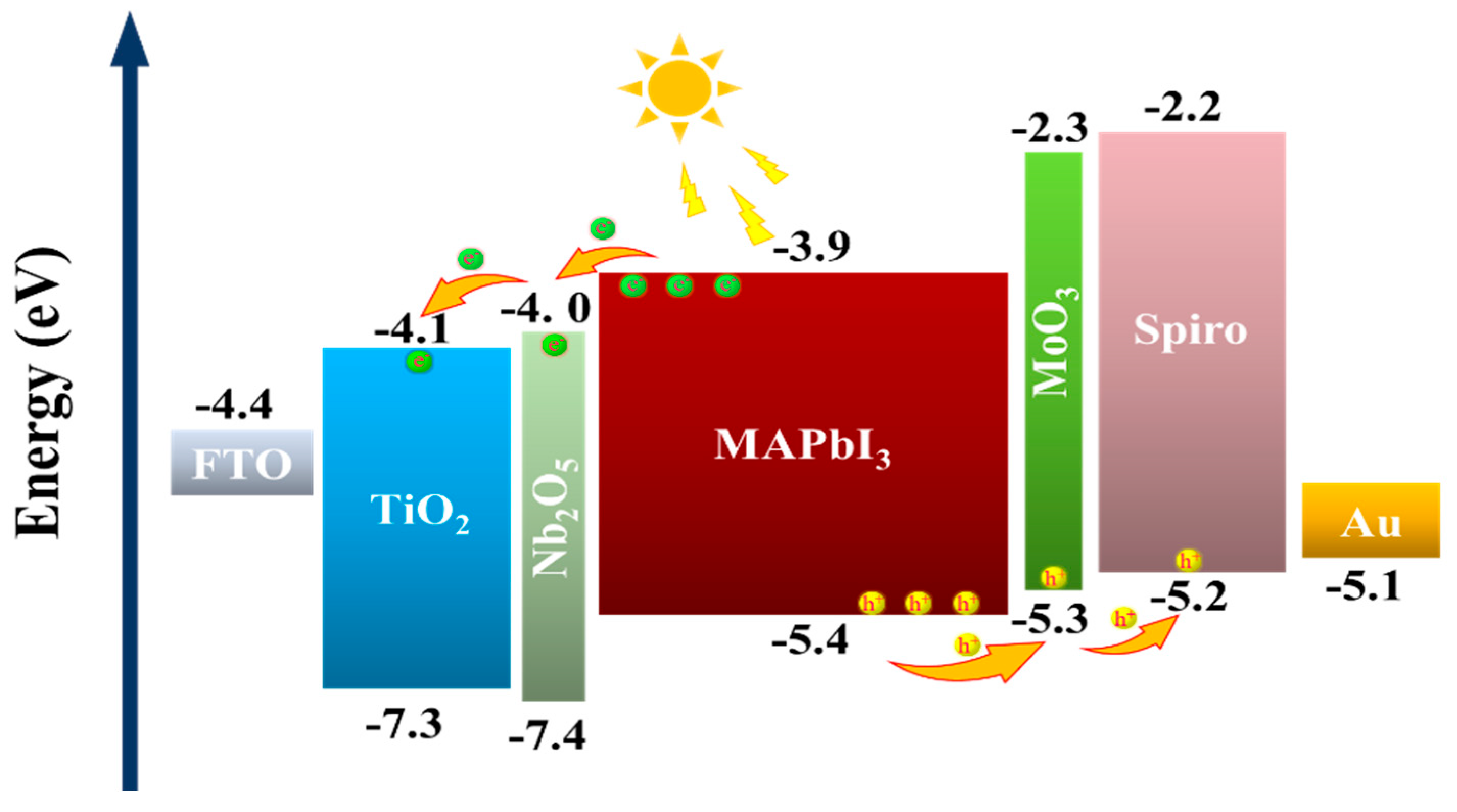
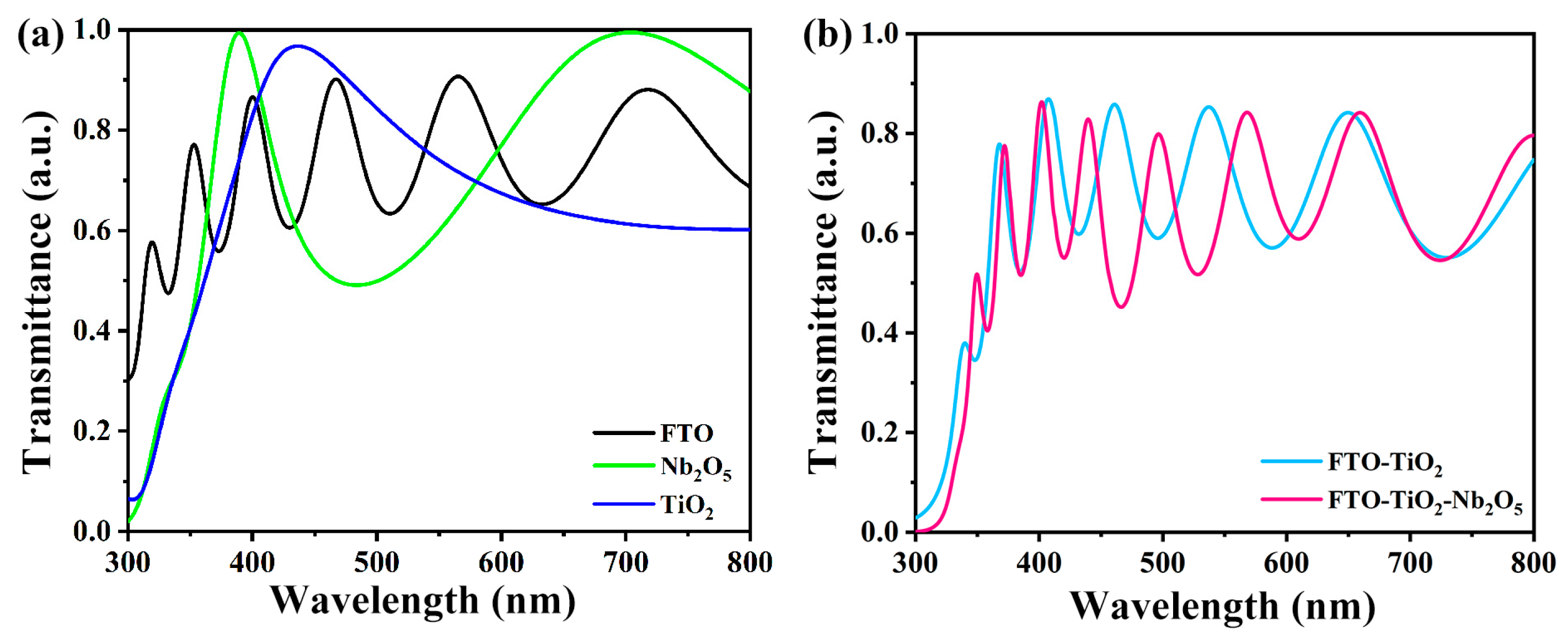


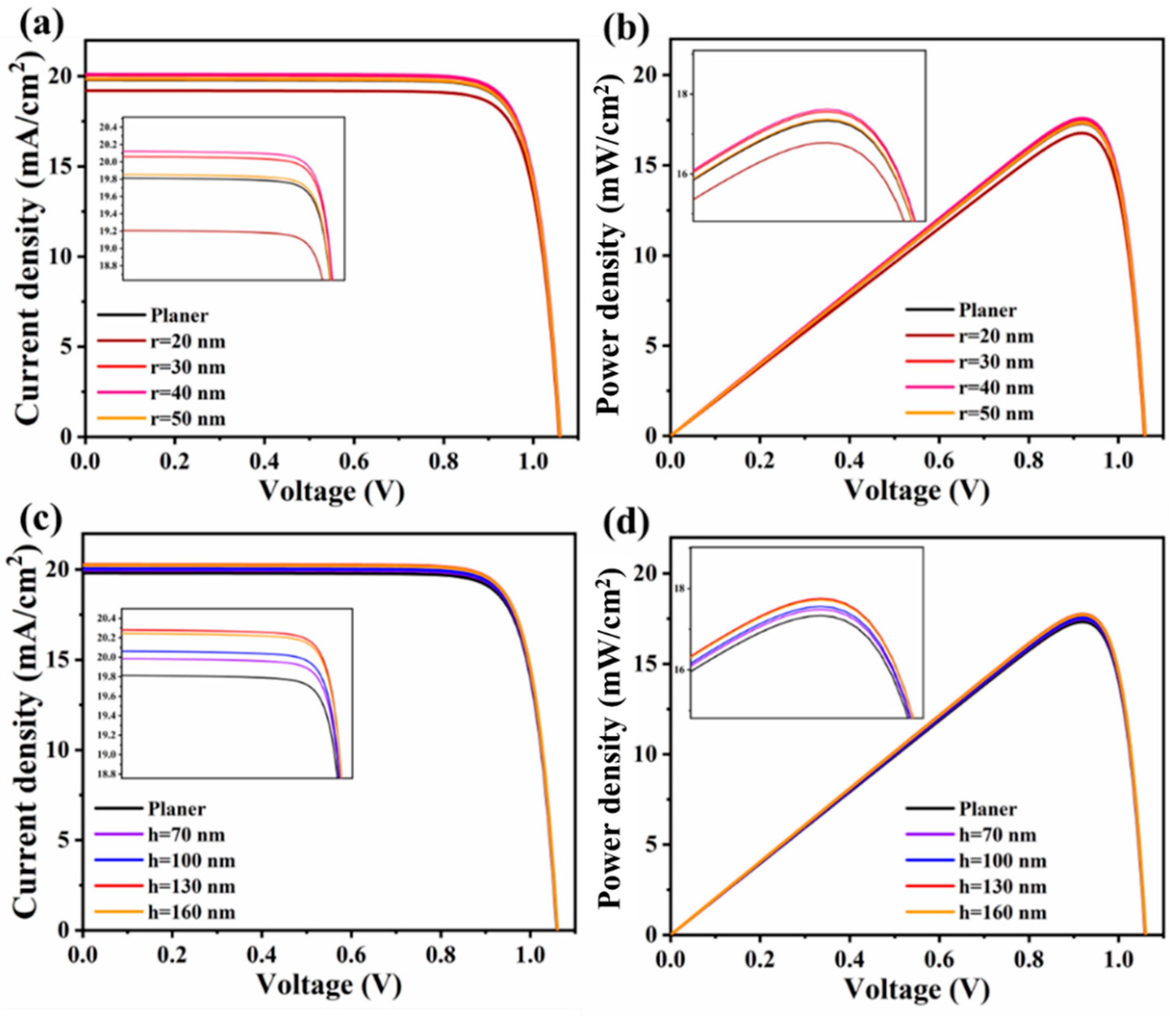
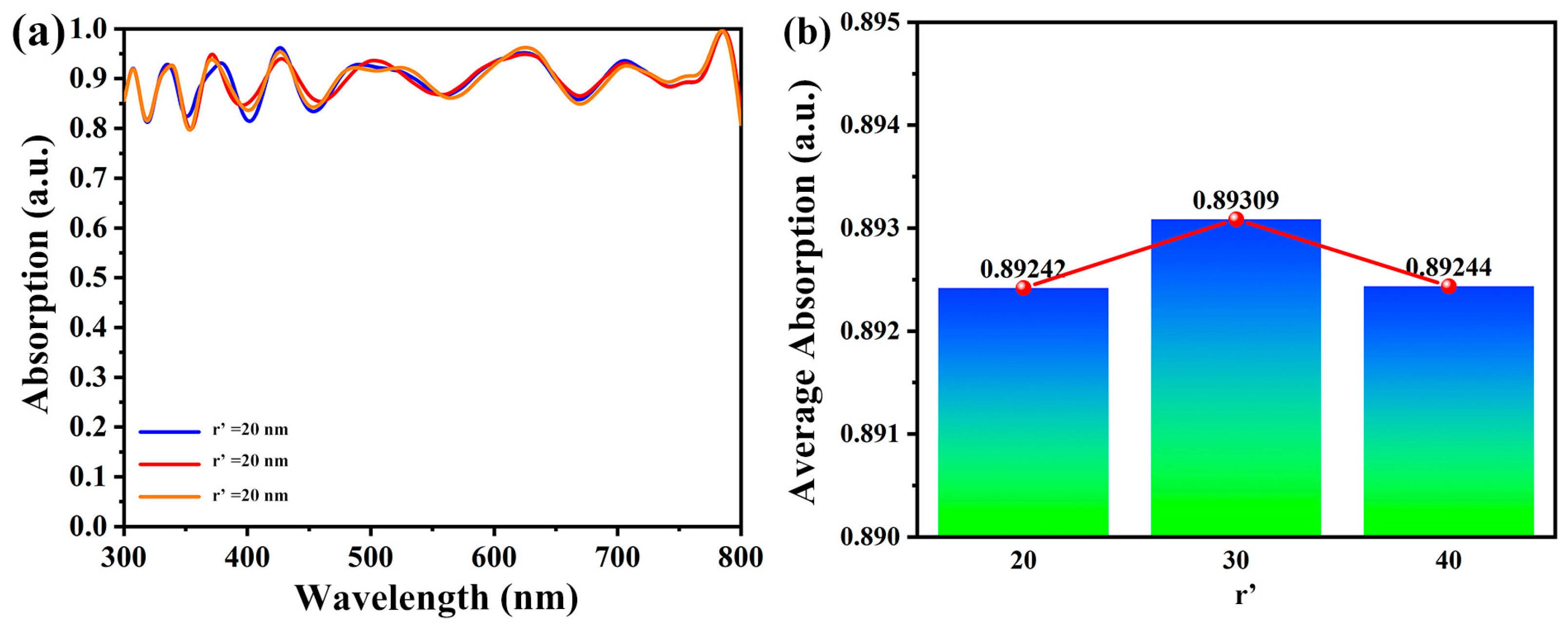
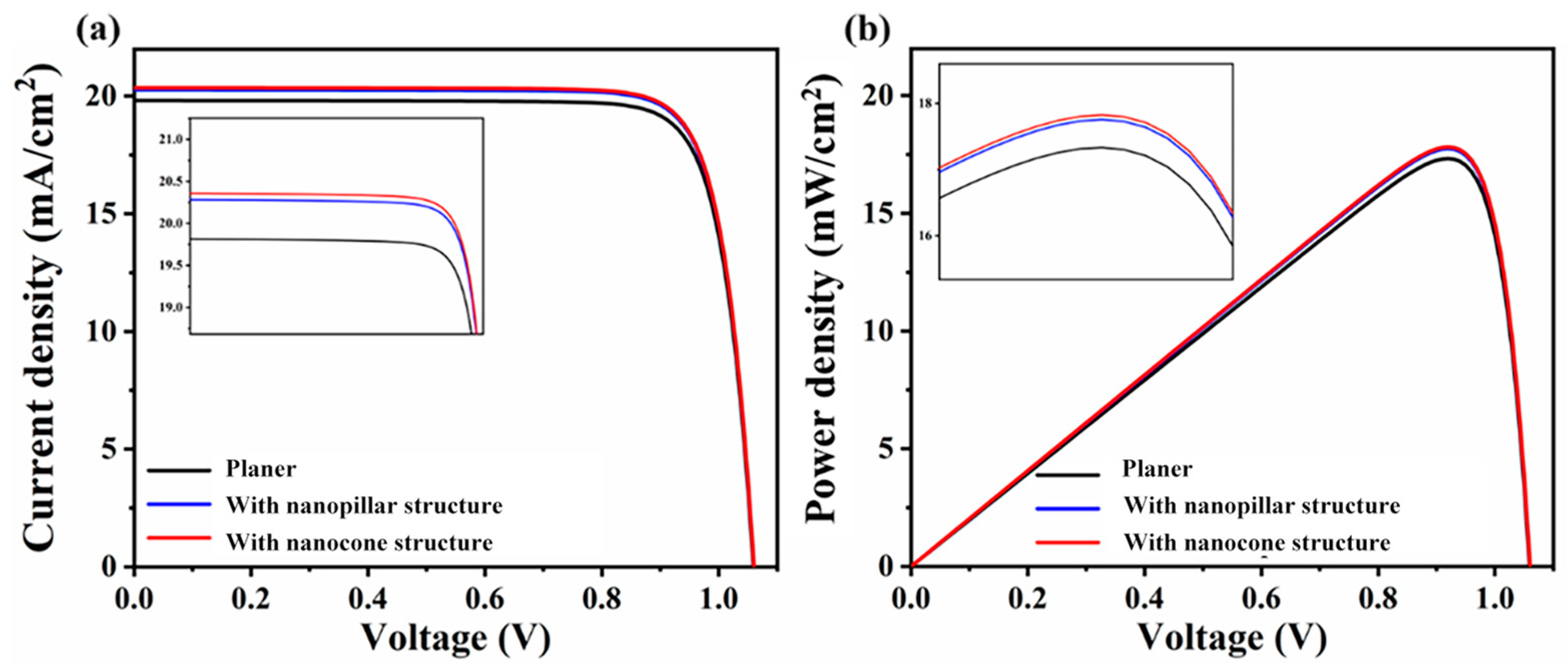
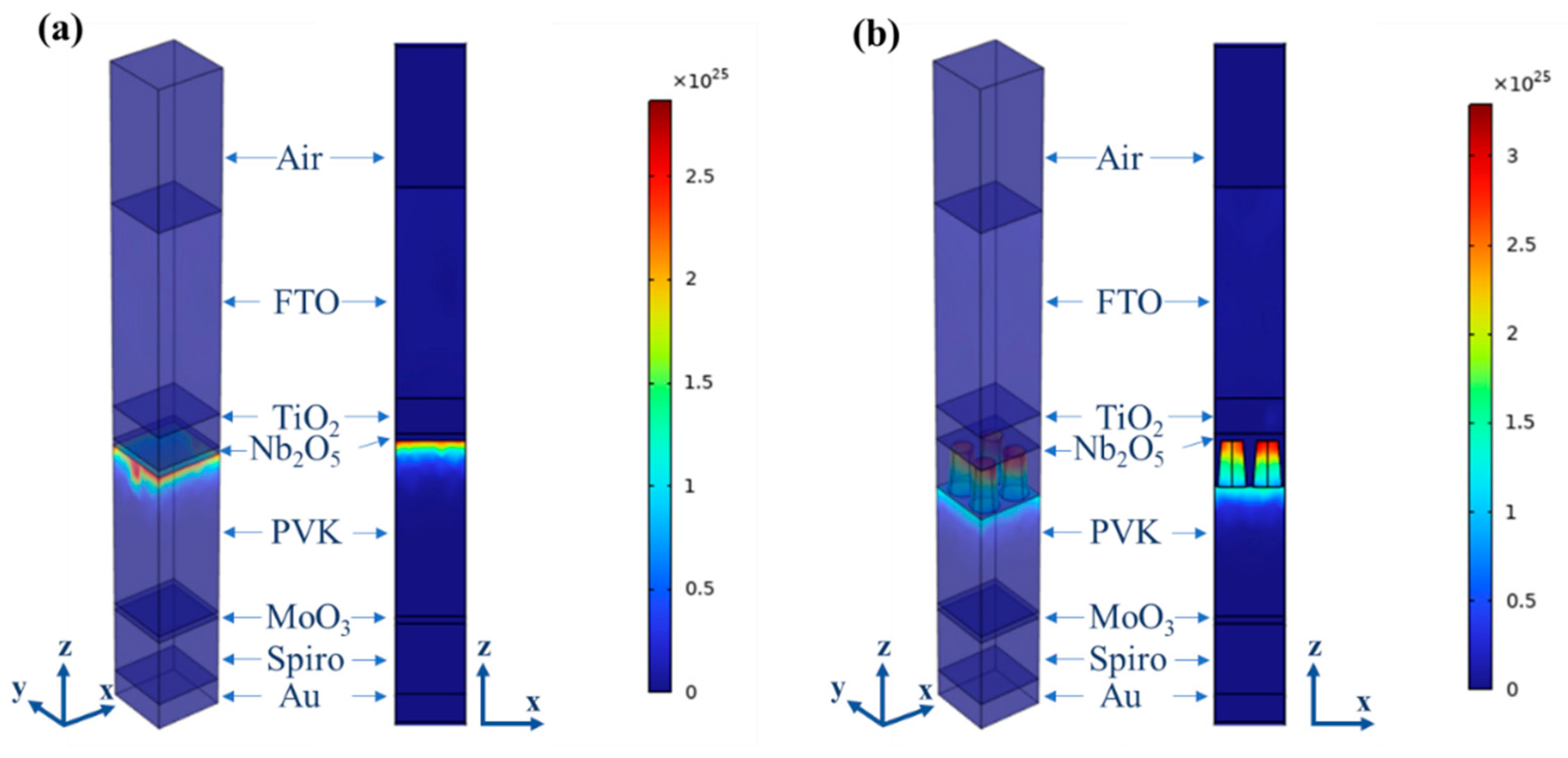
| Parameters | FTO | TiO2 | CH3NH3PbI3 | Spiro-OMeTAD | Nb2O5 | MoO3 |
|---|---|---|---|---|---|---|
| thickness(nm) | 600 | 100 | 500 | 200 | 20 | 20 |
| 3.5 | 9 | 6.5 | 3 | 10 | 12.5 | |
| Eg (eV) | 4 | 3.2 | 1.55 | 3.04 | 3.4 | 2.9 |
| X (eV) | 9 | 4 | 3.93 | 2.11 | 3.9 | 2.5 |
| Nc (cm−3) | 1 × 1019 | 1 × 1019 | 1.66 × 1019 | 2.2 × 1018 | 2.2 × 1018 | 2.2 × 1018 |
| Nv (cm−3) | 1 × 1019 | 1 × 1019 | 5.41 × 1019 | 1.8 × 1019 | 1.8 × 1019 | 1.8 × 1019 |
| µn (cm2/Vs) | 20 | 20 | 50 | 2 × 10−4 | 20 | 25 |
| µp (cm2/Vs) | 10 | 10 | 50 | 2 × 10−4 | 0.1 | 100 |
| Type | Voc (V) | Jsc (mA/cm2) | FF (%) | PCE (%) | |
|---|---|---|---|---|---|
| Planer | 1.06 | 19.81 | 82.53 | 17.33 | |
| Nanopillar | r (nm) | ||||
| 20 | 1.06 | 19.21 | 82.46 | 16.79 | |
| 30 | 1.06 | 20.06 | 82.58 | 17.56 | |
| 40 | 1.06 | 20.12 | 82.57 | 17.61 | |
| 50 | 1.06 | 19.85 | 82.55 | 17.37 | |
| h (nm) | |||||
| 70 | 1.06 | 19.99 | 82.54 | 17.49 | |
| 100 | 1.06 | 20.12 | 82.57 | 17.61 | |
| 130 | 1.06 | 20.28 | 82.62 | 17.76 | |
| 160 | 1.06 | 20.24 | 82.59 | 17.72 | |
| Nanocone | 1.06 | 20.36 | 82.62 | 17.83 |
Disclaimer/Publisher’s Note: The statements, opinions and data contained in all publications are solely those of the individual author(s) and contributor(s) and not of MDPI and/or the editor(s). MDPI and/or the editor(s) disclaim responsibility for any injury to people or property resulting from any ideas, methods, instructions or products referred to in the content. |
© 2025 by the authors. Licensee MDPI, Basel, Switzerland. This article is an open access article distributed under the terms and conditions of the Creative Commons Attribution (CC BY) license (https://creativecommons.org/licenses/by/4.0/).
Share and Cite
Liu, L.; Liu, W.; Liu, Q.; Chen, Y.; Yang, X.; Zhang, Y.; Yi, Z. Synergistic Energy Level Alignment and Light-Trapping Engineering for Optimized Perovskite Solar Cells. Coatings 2025, 15, 856. https://doi.org/10.3390/coatings15070856
Liu L, Liu W, Liu Q, Chen Y, Yang X, Zhang Y, Yi Z. Synergistic Energy Level Alignment and Light-Trapping Engineering for Optimized Perovskite Solar Cells. Coatings. 2025; 15(7):856. https://doi.org/10.3390/coatings15070856
Chicago/Turabian StyleLiu, Li, Wenfeng Liu, Qiyu Liu, Yongheng Chen, Xing Yang, Yong Zhang, and Zao Yi. 2025. "Synergistic Energy Level Alignment and Light-Trapping Engineering for Optimized Perovskite Solar Cells" Coatings 15, no. 7: 856. https://doi.org/10.3390/coatings15070856
APA StyleLiu, L., Liu, W., Liu, Q., Chen, Y., Yang, X., Zhang, Y., & Yi, Z. (2025). Synergistic Energy Level Alignment and Light-Trapping Engineering for Optimized Perovskite Solar Cells. Coatings, 15(7), 856. https://doi.org/10.3390/coatings15070856







